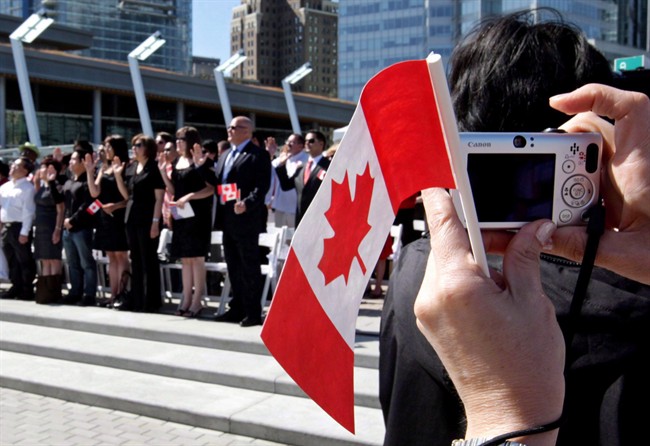The federal government announced Wednesday that Canada will increase its immigration intake by 2021, accepting 350,000 individuals in a single year.

The announcement, made by Immigration Minister Ahmed Hussen, comes as part of a three-year immigration plan.
READ MORE: Canada to raise immigrant intake to 350,000 in 2021
The vast majority of these newcomers will come under economic programs designed to address skills shortages and gaps in the labour market.
Hussen said economic immigration is badly needed in areas across the country that are short on workers and long on older residents.
“In certain regions the hunger for workers is huge,” he said.
“This plan is making us very competitive in the global market. It enables us to continue to be competitive, it enables us to continue to present Canada as a welcoming country and to position us to continue to be (a leader) in skills attraction.”
Global News reached out to Immigration, Refugees and Citizenship Canada with questions on Hussen’s announcement, asking where exactly the government hopes to settle these immigrants. The government did not respond by time of publication.
What are economic immigrants?
Economic immigrants are individuals who come to Canada for career opportunities, seeking an improvement in living standards.
John Shields, a politics professor from Ryerson University, explained to Global News that these immigrants are admitted based on their education, skills and work experience, and are considered “more resilient in terms of getting jobs.”
The 2018 Annual Report to Parliament on Immigration outlines almost half of these immigrants between the ages 25 and 64 hold a bachelor’s degree or higher — that’s compared to under 25 per cent of the age group among the Canadian-born population.
In 2017, the top five jobs for principal applicants were information systems analysts and consultants, software engineers, computer programmers and interactive media developers, financial auditors and accountants, and administrative assistants.
Where do the Liberals want them to settle in Canada?
Shields explained that major cities such as Toronto, Vancouver and Montreal are still quite popular among immigrants, but the trends are opening up to include other regions such as Calgary and Edmonton.
The 2018 report on immigration also explains that last year, 34 per cent of economic immigrants did not settle in major cities, such as Montreal, Toronto and Vancouver. That’s compared to 10 per cent who settled outside those cities in 1997.
WATCH: Trudeau says conversations to be had over Quebec stance on immigration

“There are many smaller communities across the country that are trying to attract newcomers,” Shields explained, noting that because of mobility rights the government can’t exactly tell immigrants where to settle in the long term.
What he said they can do is offer incentives, highlight opportunities within those communities and create infrastructure — such as settlement agencies — that support immigrants.
What worker shortages are they talking about exactly?
The reason these communities go to lengths to attract newcomers is that their existing population is aging.
The immigration report highlights that there are gaps in Canada’s workforce, which are at risk of becoming worse as older workers retire. Immigrants can help fill those gaps.
- Freeland set to table 2024 federal budget in the House of Commons
- Budget 2024: Liberals look to offset drug plan cost with higher smoking, vaping taxes
- Tired of after-hours emails? Budget 2024 plans ‘right to disconnect’
- Budget 2024 commits $5B for Indigenous loan guarantees, but falls short on infrastructure
Some industries highlighted in the report that stand to benefit from immigrant workers include health care, science, transport and equipment, and other skilled trades.
READ MORE: 450,000 immigrants a year? Canada could do it, report suggests
Beyond these general industries, Shields noted that provinces also have unique needs that they seek to fulfil through immigration.
The federal government gives them the chance to try to attract those workers through the Provincial Nominee Program.
“The growth of the Provincial Nominee programs over the past 20 years, coupled with the introduction of the Atlantic Immigration Pilot in 2017, has helped shift immigration landing patterns beyond the largest cities,” the federal report explains.
Shields noted the example of Manitoba, which he said has successfully used the provincial nomination program to its benefit.
“They had a lot of needs in some of their smaller communities for immigrants to work in areas such as meat packing,” he explained. “Through the provincial nomination program, they were able to bring in these workers. It’s an area where a lot of Canadian-born residents are just not very keen on working.”
WATCH: Jean Chrétien says Canada ‘needs immigrants’

Advocates push for more immigrants
As the Liberals announced plans to up the number of immigrants allowed into Canada, advocates pushed the country to do more.
Many immigration advocates and economic groups had called for bigger increases to Canada’s immigration numbers. The government’s own economic advisory council suggested admitting 450,000 people in a report in 2016.
READ MORE: Reality check — Is Canada facing an asylum seeker ‘crisis?’
But Hussen said the government is taking a slower, more “measured approach” on the topic.
Shields explained that economically, Canada can likely support 450,000 immigrants a year. But Liberals upping the number more gradually makes sense politically.
“It needs to be acceptable in terms of the politics of it. We know that immigration is a very sensitive topic,” he said, adding that dramatic increases could cause a game of “political football.”
And that is something the Liberals seem to be cautious about.
The government has launched a campaign called Immigration Matters, which seeks to shed light on why newcomers are beneficial to the country.
— With files from the Canadian Press




Comments